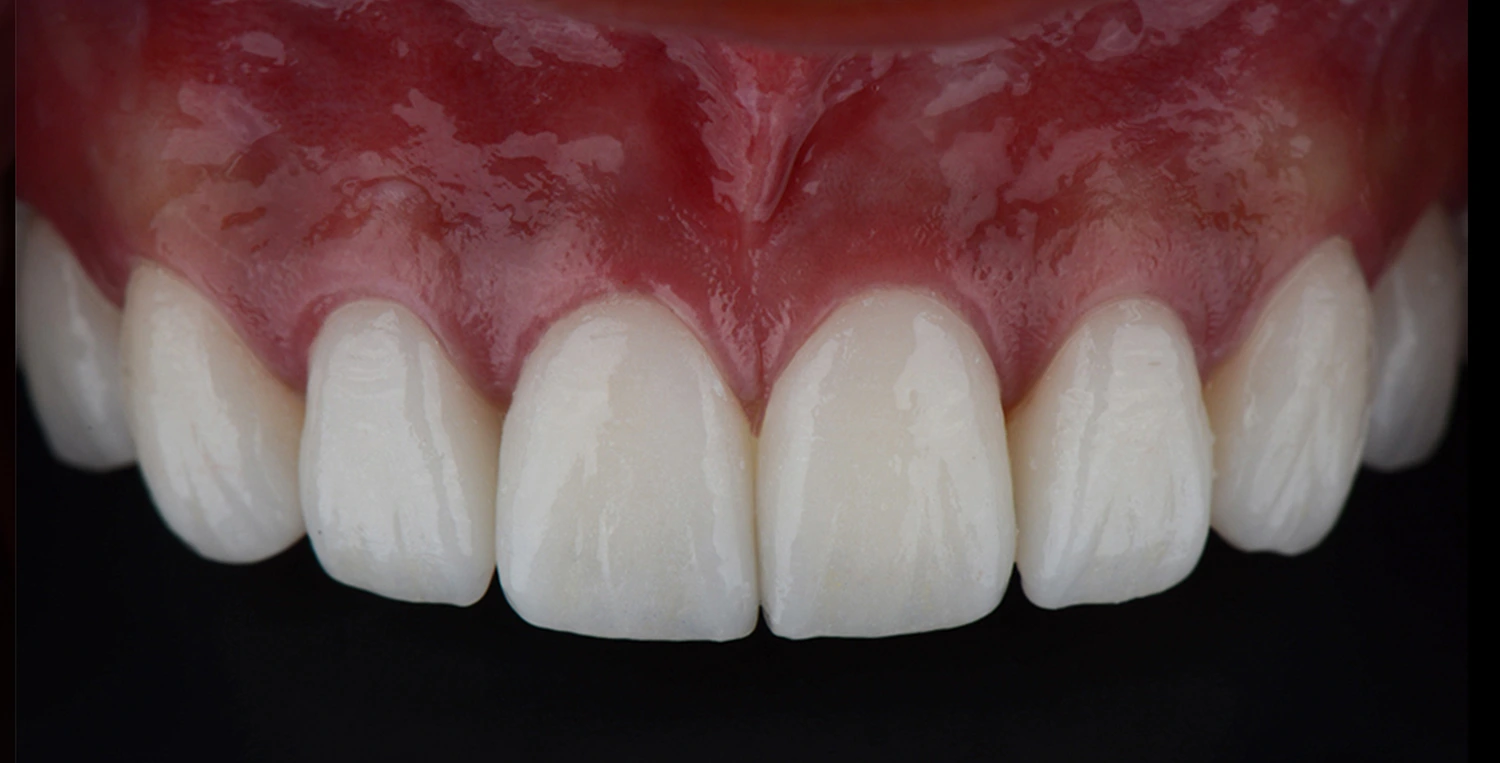
The author of the article
Boris Lipovetskiy, DMD, 31 years experience
Our team of dentists at Advanced Dental Wellness Center will discuss whether veneers are harmful to your teeth, what considerations should be made before their placement, and which materials are best: porcelain, zirconium dioxide, or composite.
Table of Contents
What You Need to Know About Veneers?
Veneers for the front teeth are non-removable micro-prostheses, crafted in the form of thin plates from composite, porcelain, or zirconium. They are incredibly thin, only 0.5-0.7 mm, with an even thinner variant Lumineers, measuring 0.2-0.3 mm.
Veneers are applied to the front surface of the teeth and they:
- Quickly and perfectly solve most aesthetic issues
- Cover chips, cracks, discoloration, or yellowing of the enamel
- Correct minor misalignments and wide interdental spaces
However, there are several facts you should consider before deciding on the procedure:
-
The changes are irreversible
Enamel is etched before placement. In case of damage or end of lifespan, veneers need to be replaced, or more radical prosthetics methods might be required.
-
Veneers do not last a lifetime
With very careful handling, they can last up to 20 years, but typically less. Expect 10-15 years for porcelain and up to 7 years for composites.
-
Shade is matched to your teeth
Should not stand out from adjacent teeth. They are semi-transparent. Too gray or yellow enamel will unattractively show through the veneers.
-
Teeth should be lightened beforehand
Undergo professional dental cleaning and whitening in a clinic. The whiter the enamel, the lighter and more beautiful the veneers your orthodontist can place.
-
Discrepancy with the color of your own teeth
Ceramic veneers do not stain, wear out, or change color, but enamel does. After a few years, you may notice that the shade of natural teeth differs.
-
Veneers do not cure tooth diseases
It only masks defects but cannot eliminate deep cavities, hypersensitivity, or correct a bad bite.
Step-by-Step Process of Veneer Placement
Achieving the perfect smile requires only three visits to the dentist, during which the dentist will work step-by-step to restore your teeth.
During the initial visit, the doctor listens to the patient's desires for smile improvement and examines the oral cavity. The head doctor at ADW – Boris Lipovetsky, not only assesses the external condition of the teeth but also identifies and addresses the true causes of an imperfect smile. He evaluates the condition of the jaw joint and bite using T-Scan and selects suitable material, shape, and color.
The oral cavity is scanned with an intraoral camera. The digital impression is sent to a dental laboratory, where a 3D model of the future perfect smile is created. The shape and color are agreed upon with the patient.
Professional oral hygiene is conducted. Hard tartar, bacterial, and pigmented plaque are removed. If necessary, the enamel is whitened. Tooth and gum diseases are treated.
The common misconception that veneers damage teeth is related to the preparation process. However, there's no need to worry. ADW dentists remove only a superficial layer of enamel, 0.1-0.3 mm thick, without affecting the inner tissues – the dentin. Micro-invasive etching won’t harm the teeth. Anesthesia is used if necessary.
Digital impressions are taken again of the etched teeth. Based on these, temporary veneers are created on the same day. The patient will wear them until the permanent ones are placed: up to 10 days.
The enamel is sterilized, dried, and etched. Dental adhesive is applied. Each veneer is fixed individually.
An ideal placement and fit of the micro-prostheses are achieved thanks to precise digital impressions and the 3D model, which the doctor uses to coordinate every action.
As long as the veneers are in place, they protect the teeth from damage. However, micro-damage to the enamel is inevitable when they are removed. Therefore, it's better to opt for zirconia prostheses, which can last a record long time: up to 20 years.
Can Veneers Cause Cavities?
Patients often mistakenly believe that veneers are harmful to teeth because they think cavities develop underneath them. However, this is not the case.
Cavities develop due to the accumulation of food particles and plaque. Before placing veneers, the enamel is thoroughly sterilized and dried. They are fixed with a special strong adhesive. There are no gaps left between them and the natural tissues where bacteria and acids can penetrate. Plaque does not accumulate on their surface.
Therefore, veneers do not provoke the development of cavities; on the contrary, it prevents them. However, plaque still accumulates on the inner parts of the teeth. It is essential to remove it with ultrasound at the dentist every six months.
How the Material of Veneers Affects the Teeth
The condition of the teeth after veneering greatly depends on the material used. The most safe and aesthetic materials are porcelain and zirconium.
Advantages of Porcelain Veneers:
-
Natural Appearance
Medical-grade porcelain perfectly mimics the semi-transparency of natural enamel. Like natural enamel, the transparency of the porcelain increases from the gum line to the cutting edge.
-
Individuality
The color and shape are tailored according to the appearance of your natural teeth.
-
Resistance
Porcelain is significantly smoother than natural enamel. It does not stain under the influence of food dyes, does not wear out, and plaque does not accumulate on it.
-
Durability
Is performed using E.max technology, which produces the most reliable porcelain veneers. Their flexural strength reaches 400 MPa.
-
Safety
Porcelain does not cause allergies and does not irritate the gums.

Advantages of Zirconia Veneers:
-
Reliability
Zirconium dioxide is the strongest material for veneering, with a strength of 850-1200 MPa.
-
Aesthetics
Zirconia can give your smile a dazzlingly white appearance.
-
Strong Adhesion
It fits perfectly to the dental tissues, eliminating gaps where food particles and bacteria can penetrate.
-
Biocompatibility
It has high compatibility with natural tissues, does not cause allergies or irritation, and is not rejected by the body.
-
Resistance
It does not stain with food pigments, maintaining its whiteness and shine for a long time.
-
Durability
Zirconium dioxide has a record-long lifespan of up to 20 years.

Porcelain and zirconia veneers are made from premium materials. They significantly surpass composite in strength, safety, and aesthetics.
The choice of material depends on your preferences. Porcelain looks more natural. Zirconium will make your smile as bright as those of Hollywood stars. Therefore, zirconia veneers are better suited for covering all front teeth on both the upper and lower jaws.
How to Protect Teeth with Veneers?
To keep your teeth healthy and extend the lifespan of your veneers, follow the advice from the doctors at the American Academy of Cosmetic Dentistry:
-
Avoid Staining Foods and Beverages
Limit the consumption of coffee, black tea, sodas, red wine, chocolate, and certain berries. This advice is primarily for patients with composite veneers. Porcelain and zirconia veneers are more resistant to staining.
-
Quit Smoking
Tar and nicotine negatively affect the aesthetics of veneers, and hot smoke or steam can burn and dry out the mucous membrane, leading to gum diseases, root mobility, and exposed tooth necks, which weaken the attachment strength.
-
Maintain Oral Hygiene
Brush your teeth twice a day with a soft or medium-bristled toothbrush. Use special toothpaste for dental restorations. Don't forget about dental floss and mouthwash.
-
Avoid Excessive Loads
Do not bite into hard foods like steaks, apples, pears, or chew on nuts and corn on the cob. Avoid biting thread, opening packages or bottle caps with your teeth. Eliminate harmful habits like biting nails or pencils.
-
Protect Your Teeth During Sports
Wear a mouthguard when engaging in contact sports.
-
Regular Preventative Care
Visit the dentist for check-ups every six months. Regularly perform professional oral hygiene. Timely address any tooth or gum diseases. Check with your orthodontist the condition of your bite and jaw joint.
Do not use toothpicks to remove food remnants as you may chip the edges of the veneers. Use thin waxed dental floss or, even better, an irrigator for thorough cleaning between teeth and along the gum line.
FAQ
After the veneers are fixed, minor discomfort is possible, related to increased tooth sensitivity and gum swelling. This is how the body reacts to foreign objects in the mouth. Unpleasant symptoms will disappear on their own within 10-14 days.


